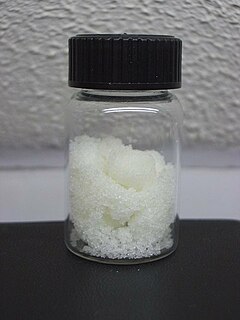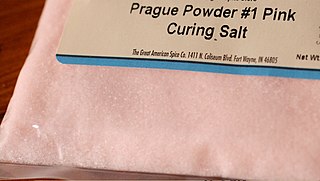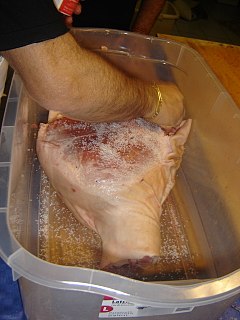Related Research Articles

A carcinogen is any substance, radionuclide, or radiation that promotes carcinogenesis, the formation of cancer. This may be due to the ability to damage the genome or to the disruption of cellular metabolic processes. Several radioactive substances are considered carcinogens, but their carcinogenic activity is attributed to the radiation, for example gamma rays and alpha particles, which they emit. Common examples of non-radioactive carcinogens are inhaled asbestos, certain dioxins, and tobacco smoke. Although the public generally associates carcinogenicity with synthetic chemicals, it is equally likely to arise in both natural and synthetic substances. Carcinogens are not necessarily immediately toxic; thus, their effect can be insidious.

In genetics, a mutagen is a physical or chemical agent that permanently changes genetic material, usually DNA, in an organism and thus increases the frequency of mutations above the natural background level. As many mutations can cause cancer, such mutagens are therefore carcinogens, although not all necessarily are. All mutagens have characteristic mutational signatures with some chemicals becoming mutagenic through cellular processes.

The nitrite ion has the chemical formula NO−
2. Nitrite is widely used throughout chemical and pharmaceutical industries. The nitrite anion is a pervasive intermediate in the nitrogen cycle in nature. The name nitrite can also refer to organic compounds with the – ONO group, which are esters of nitrous acid.

Sodium nitrite is an inorganic compound with the chemical formula NaNO2. It is a white to slightly yellowish crystalline powder that is very soluble in water and is hygroscopic. From an industrial perspective, it is the most important nitrite salt. It is a precursor to a variety of organic compounds, such as pharmaceuticals, dyes, and pesticides, but it is probably best known as a food additive used in processed meats and (in some countries) in fish products.

Nitrosamines (or more formally N-Nitrosamines) are organic compounds of the chemical structure R2N−N=O, where R is usually an alkyl group. They feature a nitroso group (NO+) bonded to a deprotonated amine. Most nitrosamines are carcinogenic in nonhuman animals. A recent systematic review supports a "positive association between nitrite and nitrosamine intake and gastric cancer, between meat and processed meat intake and gastric cancer and oesophageal cancer, and between preserved fish, vegetable and smoked food intake and gastric cancer, but is not conclusive".
Science by press conference is the practice by which scientists put an unusual focus on publicizing results of research in the media. The term is usually used disparagingly. It is intended to associate the target with people promoting scientific "findings" of questionable scientific merit who turn to the media for attention when they are unlikely to win the approval of the professional scientific community.

Pancetta is a salt-cured pork belly salume. In Italy, it is often used to add depth to soups and pastas.

Processed meat is considered to be any meat which has been modified in order to either improve its taste or to extend its shelf life. Methods of meat processing include salting, curing, fermentation, smoking, and/or the addition of chemical preservatives. Processed meat is usually composed of pork or beef, but also poultry, while it can also contain offal or meat by-products such as blood. Processed meat products include bacon, ham, sausages, salami, corned beef, jerky, hot dog, lunch meat, canned meat and meat-based sauces. Meat processing includes all the processes that change fresh meat with the exception of simple mechanical processes such as cutting, grinding or mixing.
Generation Rescue is a nonprofit organization that advocates the scientifically disproven view that autism and related disorders are primarily caused by environmental factors, particularly vaccines. The organization was established in 2005 by Lisa and J.B. Handley. Today, Generation Rescue is known as a platform for Jenny McCarthy's autism related anti-vaccine advocacy.

N-Nitrosonornicotine (NNN) is a tobacco-specific nitrosamine produced during the curing and processing of tobacco. It has been classified as a Group 1 carcinogen. Although no adequate studies of the relationship between exposure to NNN and human cancer have been reported, there is sufficient evidence that NNN causes cancer in experimental animals.

Nitroso refers to a functional group in organic chemistry which has the NO group attached to an organic moiety. As such, various nitroso groups can be categorized as C-nitroso compounds (e.g., nitrosoalkanes; R−N=O), S-nitroso compounds (nitrosothiols; RS−N=O), N-nitroso compounds (e.g., nitrosamines, R1N(−R2)−N=O), and O-nitroso compounds (alkyl nitrites; RO−N=O).
Dan Olmsted was a journalist and former senior editor for United Press International (UPI), a news agency of the Unification Church company News World Communications. Olmsted wrote a series of reports suggesting a link between vaccination and autism, a hypothesis which has been disproven. His columns on health and medicine appeared regularly in The Washington Times and were syndicated nationally from UPI's Washington D.C. bureau. He owned and edited the Age of Autism website, a site he described as the "Daily Web Newspaper of the Autism Epidemic", where writers question the safety of vaccines. Olmsted wrote an article in 2002, along with reporter Mark Benjamin, which drew links between the drug Lariam given to military personnel and mental health disorders in soldiers. In 2013, the FDA issued its most serious "boxed" warning for that drug, warning that Lariam's serious psychiatric side effects may be permanent for some.

Curing salt is used in meat processing to generate a pinkish shade and to extend shelf life. It is both a color agent and a means to facilitate food preservation as it prevents or slows spoilage by bacteria or fungus. Curing salts are generally a mixture of sodium chloride and sodium nitrite, and are used for pickling meats as part of the process to make sausage or cured meat such as ham, bacon, pastrami, corned beef, etc. Though it has been suggested that the reason for using nitrite-curing salt is to prevent botulism, a 2018 study by the British Meat Producers Association determined that legally permitted levels of nitrite have no effect on the growth of the Clostridium botulinum bacteria that causes botulism, in line with the UK’s Advisory Committee on the Microbiological Safety of Food opinion that nitrites are not required to prevent C. botulinum growth and extend shelf life..

Curing is any of various food preservation and flavoring processes of foods such as meat, fish and vegetables, by the addition of salt, with the aim of drawing moisture out of the food by the process of osmosis. Because curing increases the solute concentration in the food and hence decreases its water potential, the food becomes inhospitable for the microbe growth that causes food spoilage. Curing can be traced back to antiquity, and was the primary method of preserving meat and fish until the late-19th century. Dehydration was the earliest form of food curing. Many curing processes also involve smoking, spicing, cooking, or the addition of combinations of sugar, nitrate, and nitrite.

In molecular genetics, a DNA adduct is a segment of DNA bound to a cancer-causing chemical. This process could lead to the development of cancerous cells, or carcinogenesis. DNA adducts in scientific experiments are used as biomarkers of exposure. They are especially useful in quantifying an organism's exposure to a carcinogen. The presence of such an adduct indicates prior exposure to a potential carcinogen, but it does not necessarily indicate the presence of cancer in the subject animal.
Claims of a link between the MMR vaccine and autism have been extensively investigated and found to be false. The link was first suggested in the early 1990s and came to public notice largely as a result of the 1998 Lancet MMR autism fraud, characterised as "perhaps the most damaging medical hoax of the last 100 years". The fraudulent research paper authored by Andrew Wakefield and published in The Lancet claimed to link the vaccine to colitis and autism spectrum disorders. The paper was retracted in 2010 but is still cited by anti-vaccinationists.

Andrew Jeremy Wakefield is a British anti-vaccine activist, former physician, and discredited academic who was struck off the medical register for his involvement in The Lancet MMR autism fraud, a 1998 study that falsely claimed a link between the measles, mumps, and rubella (MMR) vaccine and autism. He has subsequently become known for anti-vaccination activism. Publicity around the 1998 study caused a sharp decline in vaccination uptake, leading to a number of outbreaks of measles around the world. He was a surgeon on the liver transplant programme at the Royal Free Hospital in London and became senior lecturer and honorary consultant in experimental gastroenterology at the Royal Free and University College School of Medicine. He resigned from his positions there in 2001, "by mutual agreement", then moved to the United States. In 2004, Wakefield co-founded and began working at the Thoughtful House research center in Austin, Texas, serving as executive director there until February 2010, when he resigned in the wake of findings against him by the British General Medical Council.
Autism spectrum disorders (ASDs) or autism spectrum conditions (ASCs) describe a range of conditions classified as neurodevelopmental disorders in the DSM-5, used by the American Psychiatric Association. As with many neurodivergent people and conditions, the popular image of autistic people and autism itself is often based on inaccurate media representations. Additionally, media about autism may promote pseudoscience such as vaccine denial or facilitated communication.
The Lancet MMR autism fraud centered on the publication in February 1998 of a fraudulent research paper titled "Ileal-lymphoid-nodular hyperplasia, non-specific colitis, and pervasive developmental disorder in children" in The Lancet. The paper, authored by now discredited and deregistered Andrew Wakefield, and listing twelve coauthors, falsely claimed non-existent, causative links between the MMR vaccine, colitis, and autism. The fraud was exposed in a lengthy Sunday Times investigation by reporter Brian Deer, resulting in the paper's retraction in February 2010 and Wakefield being struck off the UK medical register three months later.
Extensive investigation into vaccines and autism has shown that there is no relationship between the two, causal or otherwise, and that vaccine ingredients do not cause autism. Vaccinologist Peter Hotez researched the growth of the false claim and concluded that its spread originated with Andrew Wakefield's fraudulent 1998 paper, with no prior paper supporting a link.
References
- ↑ Rowland, Rhonda (8 April 1999). "Bogus health scares on Internet become more common". CNN . Retrieved 25 March 2014.
- 1 2 3 Flaherty, Megan (April 12, 1999). "Harvesting Kidneys and other Urban Legends". NurseWeek. Archived from the original on 2012-08-22.
- ↑ Wakefield A, Murch S, Anthony A; et al. (1998). "Ileal-lymphoid-nodular hyperplasia, non-specific colitis, and pervasive developmental disorder in children". Lancet. 351 (9103): 637–41. doi:10.1016/S0140-6736(97)11096-0. PMID 9500320. S2CID 439791 . Retrieved 2007-09-05.
{{cite journal}}: CS1 maint: multiple names: authors list (link) (Retracted, see PMID 20137807) - ↑ Gerber JS, Offit PA (2009). "Vaccines and autism: a tale of shifting hypotheses". Clin Infect Dis. 48 (4): 456–61. doi:10.1086/596476. PMC 2908388 . PMID 19128068.
- ↑ Godlee F, Smith J, Marcovitch H (2011). "Wakefield's article linking MMR vaccine and autism was fraudulent". BMJ. 342: c7452. doi:10.1136/bmj.c7452. PMID 21209060. S2CID 43640126.
- ↑ Flaherty DK (October 2011). "The Vaccine-autism Connection: A Public Health Crisis Caused by Unethical Medical Practices and Fraudulent Science". Ann Pharmacother. 45 (10): 1302–4. doi:10.1345/aph.1Q318. PMID 21917556. S2CID 39479569.
- ↑ Hattan, David (2 February 2010). "Aspartame". Snopes . Retrieved 25 March 2014.
- ↑ "The Mouse that Roared: Health Scares on the Internet". Food Insight. May–June 1999. Retrieved 25 March 2014.
- ↑ "Shampoo". American Cancer Society. Archived from the original on 31 July 2014. Retrieved 25 March 2014.
- ↑ Wertheimer N, Leeper E (March 1979). "Electrical wiring configurations and childhood cancer". Am. J. Epidemiol. 109 (3): 273–84. doi:10.1093/oxfordjournals.aje.a112681. PMID 453167.
- ↑ Farley, John W. (27 July 2003). "Power Lines and Cancer: Nothing to Fear". Quackwatch . Retrieved 25 March 2014.
- ↑ Hafemeister, David (April 1997). "Possible Health Effects of Exposure to Residential Electric and Magnetic Fields". Physics and Society . Retrieved 25 March 2014.
- ↑ Roosli, M.; Lortscher, M.; Egger, M.; Pfluger, D.; Schreier, N.; Lortscher, E.; Locher, P.; Spoerri, A.; Minder, C. (1 August 2007). "Leukaemia, brain tumours and exposure to extremely low frequency magnetic fields: cohort study of Swiss railway employees". Occupational and Environmental Medicine. 64 (8): 553–559. doi:10.1136/oem.2006.030270. PMC 2078497 . PMID 17525094.
- ↑ "Cell Phones and Cancer". National Cancer Institute. 24 June 2013. Retrieved 26 March 2014.
- ↑ "What are the health risks associated with mobile phones and their base stations?". WHO. 20 September 2013. Retrieved 26 March 2014.
- ↑ Taubes, Gary (1 November 2000). "The Cell-Phone Scare". MIT Technology Review . Retrieved 26 March 2014.
- ↑ Clark, Libby (5 July 2012). "5 Health Scares You Can Ignore". Men's Health . Retrieved 17 July 2014.
- ↑ Processed meat, nitrites and human health